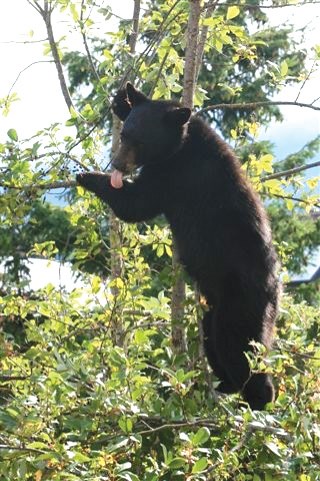In the past week, Sunshine Coast conservation officers have responded to multiple reports of bear activity as the wild animals wake up from their seasonal slumber.
Around March 31 or April 1, the presence of a mother bear and her three cubs briefly shut down construction work in the area near the Sechelt arena. Sgt. Dean Miller of the Conservation Officer Service (COS) told Coast Reporter that COS asked construction workers if they could leave the area while the four bears came out of a nearby tree.
There have been no more reports of the mother and her cubs since, Miller said, but that doesn’t mean the public hasn’t seen them. COS should be contacted for unusual bear activity and reoccurring conflicts, but if a bear is passing through an area – and not stopping or interacting with humans – there’s no need to raise the alarm.
“We have more of a coexistence mindset here on the Coast, especially with people who have been here for a while. And that’s ultimately what we want,” Miller said.
Miller set a bear trap in Secret Cove over the weekend, where there were reports of a bear breaking into vehicles, attempting to enter a residence while someone was inside, and bluff charging a person. Miller said the bear was not easily frightened, and had visible scars from previous injuries, which may have contributed to its behaviour.
While COS was unable to locate any food sources in the area, Miller said the bear was likely attracted by smell. Even a pack of gum left in a car with an open window could be enough to attract a bear, he said.
“The bear learns techniques, maybe even opens doors or break windows to get into the vehicle. From what I’ve seen, there could be food smelled in that vehicle, or there could be just nothing, like maybe even a pack of gum, which has very little smell,” he said. “That’s their key to survival is learning those things.”
While COS has limited ability to search a property, Miller said the public is often willing to help and let them look for attractants.
The trap in Secret Cove was ultimately removed after a bear matching the same description was hit by a vehicle on Highway 101 on the evening of April 4 and died. Miller said drivers should keep their eyes peeled for wildlife on and near roads.
So far this season, the COS has responded to nine bear calls. No bears have been euthanized by COS yet this year in relation to human-wildlife conflict.
Since it’s been a cold spring, Miller said that may be why there is less bear activity on the Sunshine Coast compared to this time in previous years. Now is a good time to prepare for their return. The Sunshine Coast has milder weather than much of B.C., which impacts the local bear population’s hibernation pattern. Hibernation isn’t a true sleep, Miller said, but a period of less energy because of the cold and less access to food – at least natural food sources. If a bear still has access to food, they may limit their hibernation or not hibernate at all.
Last fall, rural areas received green waste bins. While Miller said he was initially concerned about the introduction of green bins and the potential impact on bears, so far he said it may be improving the situation. When a bear doesn’t find food in a garbage tote, it will be less inclined to open the totes. The green bins should be properly stored, however, and COS recommends keeping them in a locked area that is difficult for bears to access.
More information about how to prevent wildlife conflict can be found at www2.gov.bc.ca/conservationofficerservice.


.png;w=120;h=80;mode=crop)